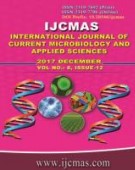


 National Academy of Agricultural Sciences (NAAS)
National Academy of Agricultural Sciences (NAAS)

|
PRINT ISSN : 2319-7692
Online ISSN : 2319-7706 Issues : 12 per year Publisher : Excellent Publishers Email : editorijcmas@gmail.com / submit@ijcmas.com Editor-in-chief: Dr.M.Prakash Index Copernicus ICV 2018: 95.39 NAAS RATING 2020: 5.38 |
Stomphastis thraustica is a very important pest of Jatropha plant, it causes great losses in the yield (seeds) of the plant which used for production of biodiesel. This work was conducted under laboratory conditions to evaluate the efficiency of two fungus isolates for controlling this pest. This study discover a new biological control method against this pest that benefit for environmental conservation. Our results indicated that the fungus Beauveria bassiana gave 92.2% mortality against both 5th larval instar and pupa at 1x108 conidia / ml concentration while this percentage decreased to 74.4% with the same previous concentration of Metarhizium anisopliae against the same larval instar. The higher pathogenicity of B. bassiana than M. anisopliae against 5th larval stage is more obvious with LC50 and LC90 values where they recorded 2.5x105 and 3.7x107 conidia / ml for B. bassiana and 1.1x107 and 8.9x108 for M. anisopliae. Although the two fungus isolates are virulent against larvae and pupae of S. thraustica, the higher pathogenicity of B. bassiana gave it the priority for controlling this pest and the two fungus isolates considered promising alternatives to chemical insecticides and recommended in IPM programs.
 |
 |
 |
 |
 |